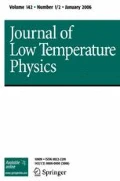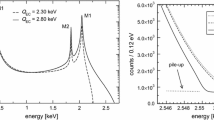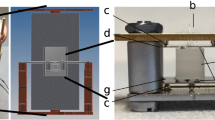Abstract
The main low temperature detectors (LTD) applications and results of LTD in fundamental physics will be considered with particular reference to the nuclear and subnuclear fields. The results obtained with cryogenic techniques and in particularly those with the hybrid ones where bolometers are operated in coincidence or anticoincidence with scintillation or semiconductor detectors will be reported and discussed. In particular the paper will refer to the results and plans in the direct determination of the neutrino mass. In connection with this subject we will review the already obtained and planned results of experiments on neutrinoless double beta decay to reveal the possible violation of the lepton number with the consequent determination or constraint on the neutrino mass. The present and future impact of low temperature techniques in direct detection of Weakly Interacting Massive Particles will be discussed in comparison with the present and future experiments with “classical” detectors. The report will be concluded by the present few and hopefully more numerous future results on the application of low temperature detectors on rare events in low energy nuclear physics.















Similar content being viewed by others
References
S.H. Moseley, An introduction to low temperature detectors, in this Special Issue LTD15 in J. Low Temp. Phys.
E. Fiorini, T. Niinikoski, Nucl. Instrum. Meth. A 224, 83 (1984)
S.H. Moseley et al., J. Appl. Phys. 56, 1263 (1984)
A. Drukier, L. Stodolsky, Phys. Rev. D 30, 2295 (1984)
G.V. Mitelmaker, B.S. Nekatov, V.N. Trofimov, Communications in Mathematical Physics (Dubna) P8–32–549 (1982)
R. Cristiano, Antonio Barone, superconductivity, Josephson effect & LT-Detectors: a Trip into Memories and Science, in this Special Issue LTD15 in J. Low Temp. Phys.
T. Klapwijk, Absorption of electromagnetic radiation and non-equilibrium superconductivity, in this Special Issue LTD15 in J. Low Temp. Phys.
S. Kempf, Microcalorimeters with inductively read out paramagnetic and superconducting temperature sensors, in this Special Issue LTD15 in J. Low Temp. Phys.
S. Golwala, Principles and applications of microwave kinetic inductance detectors, in this Special Issue LTD15 in J. Low Temp. Phys.
W. Yoon, Development of metallic magnetic calorimeters for alpha and Q spectroscopies, in this Special Issue LTD15 in J. Low Temp. Phys.
D. Hengstler, Metallic magnetic calorimeters for high-resolution X-ray spectroscopy, in this Special Issue LTD15 in J. Low Temp. Phys.
J.L. Puget, The Planck mission: performances and results, in this Special Issue LTD15 in J. Low Temp. Phys.
A. Nucciotti, Low temperature detectors for neutrino physics, in this Special Issue LTD15 in J. Low Temp. Phys.
E. Ferri, Preliminary results of MARE-1 in Milano, in this Special Issue LTD15 in J. Low Temp. Phys.
L. Gastaldo, The electron capture \(^{163}\)Ho experiment ECHo, in this Special Issue LTD15 in J. Low Temp. Phys.
S. Elliott, Mod. Phys. Lett. 27, 1230009 (2012)
E. Fiorini, CUORE: a Cryogenic underground observatory for rare events. Phys. Rep. 307, 309 (1998)
J. Lanfranchi, Cryogenic dark matter detectors: current status and future perspectives, in this Special Issue LTD15 in J. Low Temp. Phys.
J. Gascon, The EDELWEISS-III project and the rejection performance of its cryogenic germanium detectors, in this Special Issue LTD15 in J. Low Temp. Phys.
R. Strauss, Results of quenching factor measurements of CaWO\(_{4}\) at mK temperatures for the direct dark matter search experiment CRESST, in this Special Issue LTD15 in J. Low Temp. Phys.
L. Canonica, Status of the CUORE0 and CUORE neutrinoless double beta decay; Rejection of surface background in thermal detector, in this Special Issue LTD15 in J. Low Temp. Phys.
L. Taffarello, The cryogenic free dilution unit for Cuore experiment, in this Special Issue LTD15 in J. Low Temp. Phys.
L. Cardani, Scintillating bolometers for rare events searches : the LUCIFER experiment, in this Special Issue LTD15 in J. Low Temp. Phys.
L. Baudis, Direct dark matter detection: the next decade, arXiv:1211.7222v1 [astro-ph.IM] 30 Nov 2012
A.G. Cocco, Towards cosmological relic neutrino detection, Nucl. Phys. B (supplement) 866, 177–195 (2013)
Author information
Authors and Affiliations
Corresponding author
Rights and permissions
About this article
Cite this article
Fiorini, E. Application of Low Temperature Detectors in Physics: Yesterday, Today, Tomorrow. J Low Temp Phys 179, 277–290 (2015). https://doi.org/10.1007/s10909-014-1118-4
Received:
Accepted:
Published:
Issue Date:
DOI: https://doi.org/10.1007/s10909-014-1118-4




